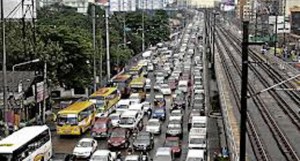MANILA, Philippines – The Metropolitan Manila Development Authority (MMDA) on Sunday warned the public to brace for heavy traffic on Edsa after the Land Transportation Franchising and Regulatory Board (LTFRB) allowed provincial buses to once again pass through the busy thoroughfare to get to their terminals in the metropolis.
MMDA Chair Francis Tolentino, in an interview on the agency’s weekly radio program, said that he was not consulted on the matter.
“I was not furnished [with] an official copy of the memorandum circular and was also [not] consulted prior to its release,” he added.
Tolentino was referring to the LTFRB’s Memorandum Circular No. 10 Series of 2014 issued on July 9 which, according to the transport board, was part of the “conduct of rationalization of routes of provincial public utility bus service.”
“With that memorandum circular, they are allowing about 2,000 buses to again enter Metro Manila and add to the daily volume of vehicles coming in,” he said.
Tolentino said that had he known about the LTFRB order, he would have consulted first the Metro Manila Council, the MMDA’s policy-making body composed of Metro mayors.
He stressed that the LTFRB’s move would make the traffic situation in the metropolis go from bad to worse, particularly with the ongoing road and infrastructure projects being conducted by the Department of Public Works and Highways.
In July 2013, the MMDA barred around 900 Cavite- and Batangas-bound buses from entering Metro Manila. As a result, Metro-bound passengers had to get off at the Southwest Integrated Provincial Transport Terminal (SWIPTT) on Coastal Road in Parañaque City and take another ride to get to their destination.
The SWIPTT was one of three integrated terminals for provincial buses ordered put up by President Aquino through Executive Order No. 67 Series of 2012, which envisioned a “centralized, intermodal and integrated bus terminal system at the fringes of Metro Manila.”
Tolentino said the LTFRB decision disregarded the policy set by Aquino, pointing out that “the President’s decision is a high-policy statement which one agency cannot just change.”
He also questioned the LTFRB’s decision to allow public utility vehicles to operate outside their approved routes for 120 days with the suspension of enforcement operations against out-of-line violations from June 19 to Oct. 17.
He stressed, however, that he would be willing to discuss these concerns with the LTFRB in a dialogue.
RELATED STORIES
Hundreds of provincial buses out of Metro by July
Provincial buses need terminals to ease Metro traffic
